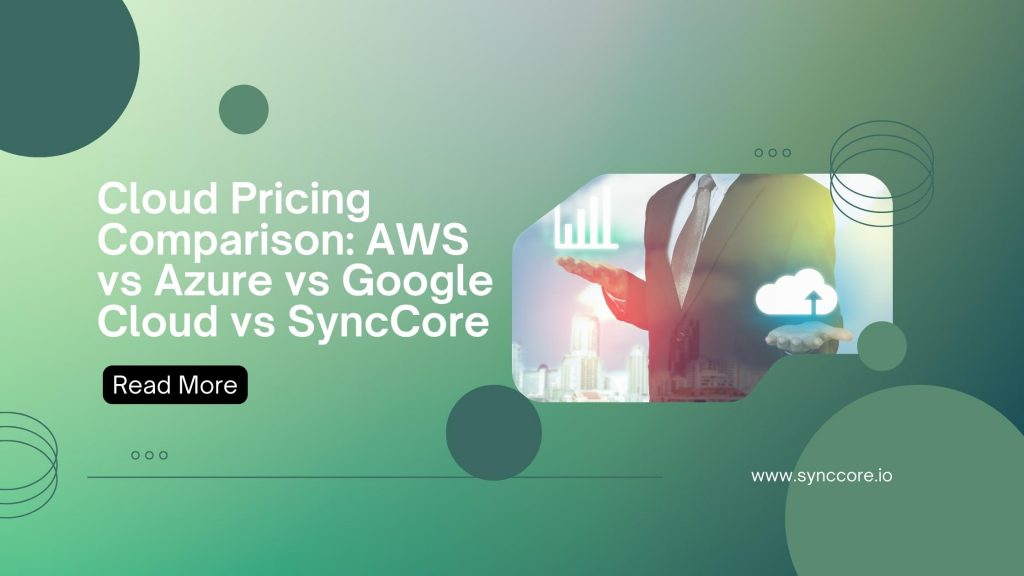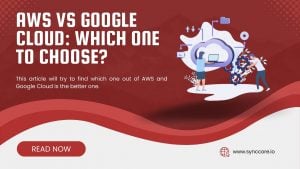Cloud Pricing Comparison: Google Cloud, Azure, SyncCore, and AWS each provide hundreds of different products, each with its service structures, technologies, and pricing models. Let us now compare them.

Table of Contents
Cloud Pricing Comparison
AWS vs. Azure vs. Google vs. SyncCore: An Overview
Amazon Web Services (AWS) is the leading cloud computing platform in the world. Its offerings include Infrastructure as a Service (IaaS), Platform as a Service (PaaS), and Software as a Service (SaaS). AWS services can provide businesses with on-demand computing power, storage, application, and content delivery.
Microsoft Azure is the name given to Microsoft’s public cloud computing platform. It offers cloud computing, analytics, storage, and networking services. Users can use these services to create and extend new applications and run existing ones in the public cloud. Azure provides a comprehensive PaaS offering and robust security features integrated with Microsoft’s security products such as Azure Active Directory and Azure Defender.
Google Cloud Platform is a collection of Google’s public cloud computing services. The platform includes several managed services for building compute, storage, and application services that run on Google hardware. Google has a more straightforward pricing model than the other providers and lower prices in many service categories. Furthermore, it provides distinct compute offerings, such as the leading managed Kubernetes service and Tensorflow Processing Units (TPUs) for AI workloads.
SyncCore offers an integrated platform for designing, testing, and deploying Cloud applications. AWS is widely regarded as being complex. The various tutorials, user guides, and troubleshooting documents are available. Conversely, SyncCore allows the utilization of the same tried and trusted technologies that several businesses have used in the past and are still using today.
Google Cloud, Azure, and AWS all have hundreds of different products. Each has its service structure, technologies, and pricing models. Each cloud will almost certainly have thousands of possible deployment combinations. This can be confusing, and the costs for each provider can be challenging to manage.
Fortunately, each provider has a pricing calculator and other tools to assist you in estimating and forecasting costs. It is critical to use these tools both before and after your migration to ensure you keep costs under control.
AWS vs. Azure vs. Google Pricing
Pricing is an essential factor when selecting a cloud platform provider. It isn’t easy to make a definitive comparison because all three providers have different pricing models and discounts. The pricing model for each provider is summarised below:
AWS:
Amazon has complex pricing for some of its models and offers dedicated tools like AWS Calculator, AWS Cost Explorer, and Trusted Advisor to help you estimate costs and identify cost-saving opportunities. At the same time, Amazon offers deep discounts on its services through various savings models, including spot instances, reserved instances, and savings plans.
Microsoft Azure:
Azure pricing is simpler to grasp. It includes a dashboard with a billing section to see exactly how much you are spending and on what. Azure provides a pricing calculator that makes estimating service costs simple and a robust enterprise budgeting system that allows you to allocate expenses across departments or business units.
Google Cloud:
Google stands out in terms of simple pricing criteria due to its appealing and customer-friendly pricing structure. To win business, it tries to undercut prices offered by other cloud service providers.
SyncCore Cloud:
Try SyncCore Cloud for free! Sign up for our free 7-day trial without commitment and deploy on the world’s fastest cloud infrastructure with affordable pricing!
Pricing is based on 27 Windows Servers and:
- 108 vCPU
- 216 GB RAM
- 5TB SSD
- 5TB HDD
- 24/7 Support
Each of the four vendors has a free tier where you can try their services before purchasing—each provider even has a “free forever” level where they provide a limited set of services on an ongoing basis.
AWS Pricing Models
Let us take a closer look at AWS pricing models.
On-Demand Pricing
Pay-as-you-go is the default AWS pricing model, and you are charged for services based on actual usage per hour or second. It is versatile, but it is also the most expensive option. Many organizations begin with on-demand pricing and then transition to other models as they gain a better understanding of their cloud requirements.
Reserved Instances
Amazon allows you to pre-order instances for one or three years, saving up to 75% off the on-demand price. When scaling down Reserved Instances in the Reserved Instance model, you cannot delete them (however, you can sell Reserved Instances on a dedicated Amazon Marketplace). Scaling up will necessitate the use of more expensive on-demand resources.
While this reduces the flexibility of Amazon services, you can still take advantage of Amazon’s advanced automation options and rich ecosystem of services. Most organizations combine models, using Reserved Instances for long-running workloads and on-demand for fluctuating workloads.
Spot Instances
Spot Instances can be found on Amazon EC2, Amazon Fargate, and various other compute services. It provides the most significant discount, up to 90% off the on-demand instance price. Spot Instances enable you to compete for reserve computing power on Amazon’s open market. The price is updated every 5 minutes, and if your bid is higher than the current market price, you will be awarded a Spot Instance.
The catch is that when capacity is unavailable or the current Spot price exceeds the maximum price, Spot Instances are terminated with only 2 minutes notice. Amazon has added a new feature that allows you to receive an advanced warning that a Spot Instance will be removed, but this is not guaranteed. Spot Fleet, an advanced mechanism that manages scalability for groups of Spot Instances and regular on-demand instances, is also available.
Azure Pricing Models
Aside from its on-demand pricing model, Azure provides two primary cost-cutting strategies: Azure VMs and Spot VMs.
Pay-As-You-Go
Azure services are charged per second, with no long-term commitments or upfront costs. This gives you the freedom to add or subtract resources as needed. The Azure autoscale feature allows virtual machines (VMs) to be automatically resized.
This pricing model is designed primarily for users who value flexibility and want to convert capital expenses into operating expenses and applications with variable or short-term workloads.
Reserved Virtual Machine Instances (RVMIs)
Azure RVMIs are pre-ordered virtual machines that require a one-year or three-year commitment in certain regions. RV can save you up to 72% off pay-as-you-go pricing.
Azure may choose to replace an RVMI with another instance during the term. Users can also cancel Reserved Instances before the end of the time, but an early termination fee will apply.
This pricing model is appropriate for applications with a consistent, stable load, organizations with a fixed budget, or large applications that regularly use a fixed number of virtual machines (such as a central management component).
Spot VMs
Compared to pay-as-you-go, Azure allows you to purchase unused compute power at up to a 90% discount. On the other hand, Spot Instances can be interrupted by unexpected notifications and are only recommended for workloads that can tolerate interruptions. The spot VM interruption notice is only 30 seconds long.
Azure provides Scale Sets for Virtual Machines (VMSS). This auto sauto-scalingnism allows you to manage groups of VMs and add Spot Instances automatically based on predefined policies. Unlike Amazon’s Spot Fleet, VMSS does not permit the combination of Spot VMs and pay-as-you-go VMs.
Spot Instances are best suited for fault-tolerant distributed applications, stateless applications, and non-emergency or highly parallelized workloads.
Google Cloud Pricing Models
The Google Cloud Platform pricing models are as follows:
Pay-As-You-Go
Google Cloud has a pay-as-you-go pricing model. This is ideal for people who only use the cloud occasionally because it allows them to add and remove services as needed. This degree of adaptability comes at a cost, and the pay-as-you-go model has the highest hourly fee on the platform.
Long-Term Commitment Plans
If you have a long-term cloud deployment strategy and can commit to a long-term commitment, you can save significantly over a pay-as-you-go model. Google offers a long-term pricing model with a one-year or three-year commitment. Google calls its plans Committed Use, offering discounts of up to 70% off the on-demand price.
Preemptible Instances
Compared to standard VM prices, preemptible VM instances (spot instances) are significantly cheaper (60-91 percent off). If the compute engine needs to reclaim add capacity for other virtual machines, it can stop (preempt) those instances with a 30-second notice. Because preemptible models consume excess Compute Engine capacity, availability depends on usage.
If your application is fault-tolerant and can tolerate instance preemption, preemptible instances can significantly reduce Compute Engine costs. Batch jobs, for example, can run on preemptible models. If a few cases are terminated, the work will be slowed but not completed—preemptible illustrations complete batch jobs without overloading existing examples or paying the total price for additional regular instances.
However, compared to AWS and Azure, Google Preemptible Instances have much less mature management capabilities, making scaling and combining them with pay-as-you-go instances more difficult.
SyncCore Cloud
Price-to-Performance Ratio
SyncCore has mastered the art of building and scaling cloud computing to provide the industry’s best price-to-performance ratio. Every cloud instance we deliver reflects our four years of experience and optimization.
Customer Service
Our highly trained professionals will answer the phone and resolve your problem. Customer experience is at the heart of everything we do at SyncCore, not our company’s add-on service.
Costs
SyncCore is known for providing high-performance cloud computing at an affordable price. Not only are we less expensive than AWS, but our pricing model is simple, flat, and predictable month after month.
Resource Pricing
Our pricing is based on per resource, such as CPU, memory storage, etc. We do not charge per virtual machine because these are not flexible options for the end user. If they only need a specific resource upgraded, such as a CPU or a disc, they can do so through SyncCore Cloud.
Conclusion
This article discussed the critical pricing differences between AWS, Azure, SyncCore, and Google Cloud.
You can get a detailed cloud pricing comparison of AWS vs. Azure vs. Google Cloud vs. SyncCore.
Choosing the correct cloud vendor is a vital role for businesses. SyncCore provides a hybrid solution, PaaS, and a variety of other valuable capabilities that are critical in today’s Cloud strategy. Migrating to SyncCore Cloud has increased business growth for many companies. As a result, SyncCore comes as a far superior option to AWS, Azure, and GCP.
If you require cloud services, please get in touch with us at [email protected] or visit our website at www.synccore.io.
Read More:
AWS vs. Azure vs. GCP vs. SyncCore: Pros & Cons
AWS vs. Azure: Which One Is Better?
AWS vs Azure vs Google Cloud vs IBM Cloud vs SyncCore Cloud: What’s the Best Cloud Environment?



